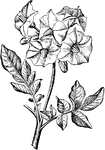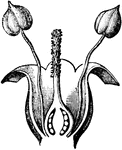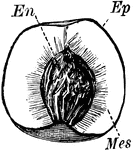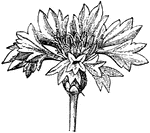
Inflorescence of a Cornflower
An illustration of the inflorescence of the cornflower. Centaurea cyanus ('Cornflower, Bachelor's button,…

Ray-floret of a Cornflower
An illustration of a ray-floret of the cornflower. Centaurea cyanus ('Cornflower, Bachelor's button,…
Disk-floret of a Cornflower
An illustration of a disk-floret of the cornflower. Centaurea cyanus ('Cornflower, Bachelor's button,…
Disk-floret of a Cornflower (Longitudinal
An illustration of a longitudinal section view of a disk-floret of the cornflower. Centaurea cyanus…
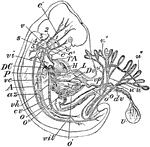
Human Embryo
"Early Human Embryo, giving diagrammatically the principal vessels antecedent to the establishment of…
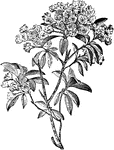
Mountain-laurel
Kalmia latifolia, commonly called Mountain-laurel or Spoonwood, is a flowering plant in the family Ericaceae,…
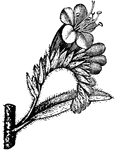
Viper's Bugloss Inflorescence
Echium vulgare (Viper's Bugloss) is a species of Echium native to most of Europe, and western and central…

Viper's Bugloss Flower
Echium vulgare (Viper's Bugloss) is a species of Echium native to most of Europe, and western and central…
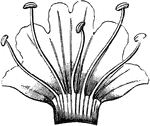
Viper's Bugloss Corolla and Stamens
Echium vulgare (Viper's Bugloss) is a species of Echium native to most of Europe, and western and central…
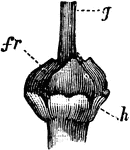
Gynaeceum of Viper's Bugloss
An illustration of the Gynaeceum of the viper's bugloss. Fr, ovary; g, base of style; h, honeyglands.
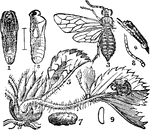
Strawberry Sawfly
"Strawberry False-worm (Emphytus maculatus). 1, 2 pupa, ventral and lateral views (line shows natural…
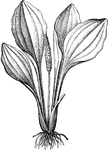
Plantain Flower
An illustration of a plantain plant. The plantain is a crop in the genus Musa and is generally used…

Plantain Flower and Bract
An illustration of a plantain plant flower and bract. In botany, a bract is a modified or specialized…
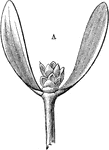
Mistletoe Flower
An illustration of the flower of the mistletoe plant. Mistletoe is the common name for a group of hemi-parasitic…

Mistletoe Staminate
An illustration of one staminate flower in section, magnified twelve times. Mistletoe is the common…
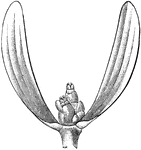
Pistillate Flowers of Mistletoe
An illustration of pistillate flowers of mistletoe. Mistletoe is the common name for a group of hemi-parasitic…
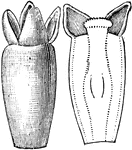
One Pistillate Flower of Mistletoe
An illustration of one pistillate flower of mistletoe. Mistletoe is the common name for a group of hemi-parasitic…
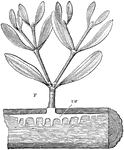
Mistletoe Attached to Host Plant
An illustration of a mistletoe plant attached to the host plant. Mistletoe is the common name for a…
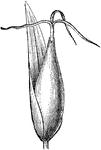
Sedge
An illustration of the female flower of the sedge plant. Carex is a genus of plants in the family Cyperaceae,…
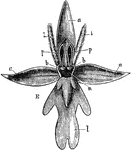
Fly Orchid
Fly orchid (Ophrys insectifera) is a plant of the family Orchidaceae, a native of the British Isles…
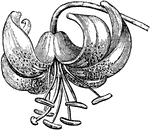
Turk's Cap Lily
Lilium martagon (Martagon or Turk's cap lily) is a species of lily. It has a widespread native region…

Lily of the Valley
Convallaria majalis, commonly known as the Lily of the Valley or Lily-of-the-Valley, is the only species…

Encrinite
"Encrinite: Any fossil crinoid; a stone-lily: a term especially applied to the ordinary stalked form…
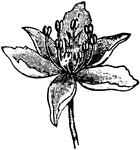
Flowering Rush
The flower of the Flowering Rush (Butomus umbellatus), the sole species in the Butomaceae family.
Common Heath
The flowering branch of the Common Heath (Epacris impressa), a plant in the Ericaceae family of heaths.

Common Heath
The flower of the Common Heath (Epacris impressa), a plant in the Ericaceae family of heaths.
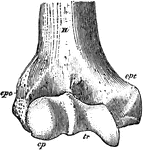
Humerus
"Anterior View, Distal End, of Right Humerus of a Man. H, humerus; epc, epicondyle, or external supracondyloid…
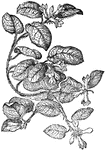
Trailing Arbutus
The Trailing Arbutus (Epigaea repens) is a spreading shrub in Ericaceae family of heaths.
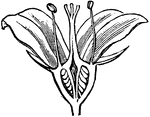
English Dogwood
The English Dogwood (Philadelphus coronarius) is a deciduous shrub, here showing its epigynous stamens…
Youth Femur
"Right Femur of a Youth. E, E, epiphyses; gtr, ltr, greater and lesser trochanter; h, head; et, it,…

Bobolink Epipleurae
"Epipleurae.-- Thorax, scapular arch, and part of pelvic arch of a bobolink (Dolichonyx oryzivorus).…

Wood Horsetail
"Equisetum sylvaticum: a, a, sheath crowned with teeth; b, branches; c, c, fruiting spikes. 2. Clypeola,…

Winter Aconite
The Winter Aconite (Eranthis hyemalis) is a European plant in the Ranunculaceae family of buttercups.

Young Prothallus of Fern
An illustration of a young prothallus: sp, spore; pr, prothallus. A prothallium, or prothallus is usually…
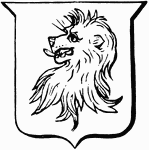
Erased
"A Lion's Head Erased. In heraldry, represented as having been forcibly torn off, the separated parts…
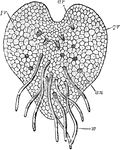
Young Prothallus of Fern
An illustration of a microscopic view under the surface of a young prothallus: pr, prothallus; w, root-hairs;…
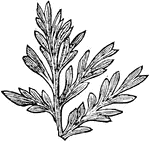
Fossil Fern
Eremopteris artemisiaefolia is a species of "a genus of fossil ferns, separated from Sphenopteris."…

Bell Heather
The magnified flower of the Bell Heather (Erica cinerea) is a plant in the Ericaceae family of heaths.
Adderstongue
Lphioglossum (adder's-tongue) is a genus of about 25-30 species of Ophioglossales in the family Ophioglossaceae,…

Monkwearmouth Church
Monkwearmouth is an area of Sunderland located at the north side of the mouth of the River Wear. It…
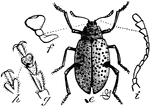
Fungus Beetle
Erotylus boisduvali, a fungus beetle. "e, beetle; f, palpus; g, tarsus, from below; h, terminal joint…
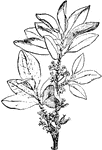
Coca
The flowering branch of the coca plant (Erythroxylon coca) best known for its use in the drug cocaine.

Coca Leaf
The leaf of the coca plant (Erythroxylon coca) best known for its use in the drug cocaine.
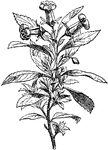
Escallonia
"Escallonia macrantha. Escallonia is a South American genus of trees or shrubs, of the natural order…

Napier's Right Spherical Triangle
Illustration of a right spherical triangle and the five circular parts placed in the sectors of a circle…
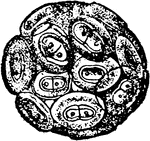
Coccolithophora
A mass of coccoliths; a marine pelagic plant of low order covered with calcereous plates. A coccolithophore…

Pike Cranium
"Cartilaginous Cranium of the Pike (Esox lucius), with its intrinsic ossifications. A, top view; 3,…
